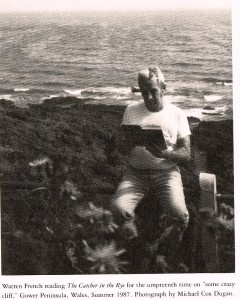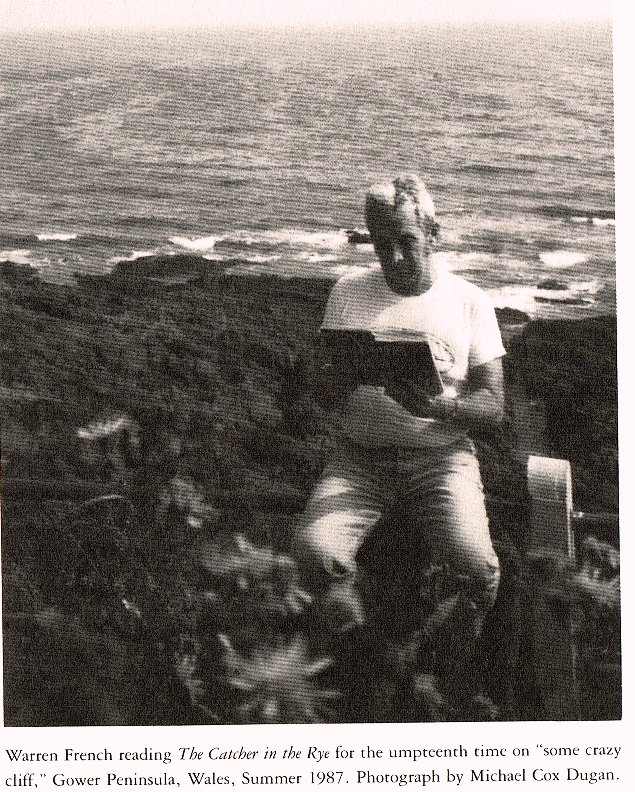MLA Citation:
French, Warren. J.D. Salinger, Revisted. Boston: Twayne, 1988. Print.
First Paragraph:
“The irony of the title of this book is that nobody visits J.D. Salinger at all without a rarely extended invitation, and certainly the least likely recipient of one would be a professional literary critic. Like many authors, Salinger feels that what he has to say can be found in his books and that readers need no outside guidance, although the tragic behavior of Mark David Chapman (John Lennon’s assassin) might suggest otherwise. (Chapman inaccurately cited Catcher in the Rye at his sentencing to justify his actions {see Chapter Three, n. 13}.) Anyway, I bring no news about Salinger himself, as I will be revisiting only the writings he has with increasing reluctance committed to print.”
from the Preface, page ix
Book Details:
In his preface, French talks about the first two editions of his book J.D. Salinger, and how this particular book emerged to mark the 25th anniversary of the first edition of the first book, and how it was meant to respond to the media attention Salinger had gotten when Mark David Chapman assassinated John Lennon, among other things.
Book Contents:
Chapter One: “That David Copperfield Kind of Crap”
Chapter Two: Breaking into Print
Chapter Three: The Holden Caulfield Story
Chapter Four: A Nine-Story Cycle
Chapter Five: The House of Glass
Chapter Six: The Search for the Seer
Chapter Seven: A “Nice and Peaceful” Place, Cornish
Summary:
“That David Copperfield Kind of Crap”
first paragraph
“Borrowed from my earlier book, this chapter title ultimately derives from Salinger himself, who used it in The Catcher in the Rye to describe the detestation he shares with Holden Caulfield of exposing Dickensian details about ‘his lousy childhood.’ Despite their aversion against curiosity seekers, even the historian disinclined toward rooting through wastebaskets feels obligated to summarize the public record.”
Breaking Into Print
first paragraph
“Bruce Bawer cannot be faulted for his judgment that almost all of Salinger’s early stories, ‘obviously manufactured for a middlebrow audience’ in well-paying and widely circulated slick magazines, were contrived productions of little or no literary interest. Salinger is surely adequately justified in his steadfast refusal since 1960 to permit reprintings. Some of these early works, however, have significant relationships to his celebrated later works that merit examination here. Those early stories involved in the curious evolution of the Holden Caulfield character will be examined in connection with The Catcher in the Rye.
The Holden Caulfield Story
first paragraph
“Back in his talkative days just after World War II, Salinger told Herschel Brickell that he might never finish a novel, because he was ‘essentially a short story writer’ and did not want to abuse his talent or spread it too thin. He did go on, however, to finish just one; and it went on to become what Bruce Bawer calls, ‘perhaps the best known story in postwar American literature.”
A Nine-Story Cycle
first paragraph
“J.D. Salinger has allowed to be collected only nine of the thirty short stories he is known to have published before the Glass family chronicle. Most disinterested editors would go along with this decision. Most of these stories have been either superseded by The Catcher in the Rye or my otherwise be regarded as apprentice works of a writer seeking to find the forms and content that satisfy him. He was not apparently satisfied with the results until he wrote ‘A Perfect Day for Bananafish,’ which began his almost exclusive association with the New Yorker, which lasted from 1948 to 1965, when his last short story appeared there.”
The House of Glass
first paragraph
“With ‘Teddy’ Salinger had written himself into a cul-de-sac, for there was no obvious place to proceed from a hero (or anti-hero to use a then very fashionable term) who chose to fly this sphere of sorrows to end a cycle of earthly reincarnations int he long-sought final union with Brahma. It is also quite possible that Salinger felt that in his controversial story about the liberation of Teddy McArdle, he had pushed too far beyond his readers’ susceptibilities during a period where he still felt concerned about them. Most Americans, even in the dreary 1950’s, had not reacched a state where they thought that the best way to deal with the world’s problems was to simply leave them behind altogether.”
second paragraph included for clarification
“The problem of finding a new direction must have preoccupied him for some time, because it was two years after the publication of Nine Stories in 1953, before his next story appeared in the New Yorker, although he had previously published at least one story every year, even during his service in the army, since his first contribution to Story in 1940. In the meantime, he had moved from fashionable Connecticut to the lonely woods of Cornish, New Hampshire, and had met Claire Douglas, whom he married in February 1955, only weeks after the publication of the first of a new sequence of five more stories, which appeared at increasingly long intervals over the decade until he ceased publishing.”
The Search for the Seer
first paragraph
“Before Salinger published ‘Zooey’ he had for undisclosed reasons resurrected Seymour Glass and composed an account of his wedding day in 1942 as experienced by his younger brother Buddy, who in ‘Raise High the Roofbeam, Carpenters’ assumes the role of the keeper of the sacred flame of his brother’s memory. In this story Salinger also has Buddy digress from the business principally before him to indulge in ‘that David Copperfield kind of crap’ about the Glass family, providing the background for further tales of its supernal brilliance, especially the marathon participation of the seven siblings in the ‘It’s a Wise Child’ radio quiz program. Salinger had apparently, however, not yet worked out all the details of this history, for nowhere in this 1955 story is it mentioned that Buddy has become writer-in-residence at a women’s college in upstate New York.”
A “Nice and Peaceful” Place, Cornish
first paragraph
“Perhaps the greatest irony of secretive Jerome David Salinger’s life is that it has disproved a principal thesis of the novel on which his reputation remains most largely based. At the depth of his despair, just before the ‘fall’ that redeems him, Holden Caulfield, demoralized by the obscenities he finds in what should be sacred places, laments, ‘You can’t ever find a place that’s nice and peaceful, because there isn’t any’ (The Catcher in the Rye, 264), and his story ends with his reluctant acceptance by ‘missing everybody’ in the world as it is.”


